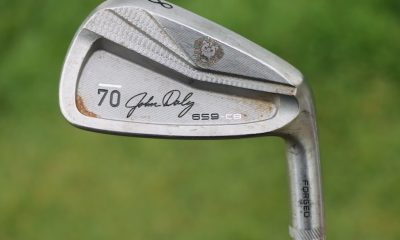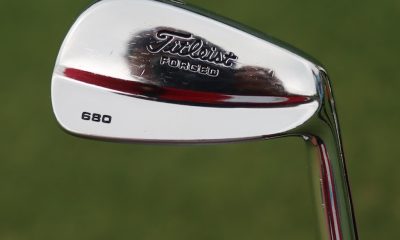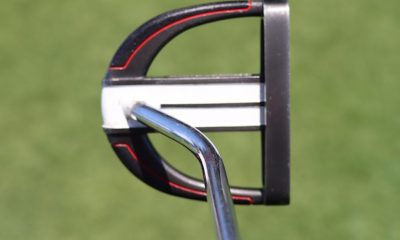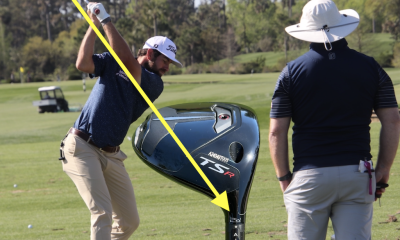Opinion & Analysis
Will leaving Titleist hurt Rory McIlroy’s game?

Golf fans learned two things about Rory McIlroy’s future today: he will no longer endorse Titleist or FootJoy products as of Dec. 31, 2012, and another OEM is going to pay him an outrageous amount of money to play its equipment.
It has been widely speculated that McIlroy has already entered into a deal with Nike Golf to the tune of 10 years, $250 million. Nike is neither confirming nor denying the rumor, meaning McIlroy’s deal with Nike is either the worst-kept secret in golf history or one of the biggest rumor-mill hoaxes of all time. But here’s what golf fans do know — McIlroy will be forced to shelve at least a few pieces of Titleist equipment he used to win the 2012 PGA Championship at Kiawah Island by a record margin of eight shots.
Whatever company signs Rory McIlroy will do its best to accommodate his equipment preferences, but equipment changes, especially for a player of McIlroy’s caliber, can be as much about sound, feel and confidence as they are performance. That’s why six-time major champion Nick Faldo said on Tuesday’s “Morning Drive” on the Golf Channel that McIlroy’s decision to change equipment was “dangerous.”
“I’ve changed clubs and changed equipment, and every manufacturer will say, ‘We can copy your clubs; we can tweak the golf ball so it fits you,’” Faldo said. “But there’s feel and sound as well, and there’s confidence. You can’t put a real value on that. It’s priceless.”
Based on the equipment McIlroy is playing now (Click here to see what was in his bag at the 2012 PGA Championship), we’ve made a list of the five biggest hurdles McIlroy will face as he migrates from Titleist equipment.
Click here for more discussion in the “Tour/Pre-release equipment” forum.
No. 5 – A new driver head/shaft combination
Like snowflakes, no two golf shafts are exactly the same. Even shafts of the same model from the same manufacturer with the same listed specifications can have minuscule differences than top ball strikers like McIlroy can notice.
McIlroy switched to a new shaft, a Mitsubishi Diamana Prototype 70X, to go along with Titleist’s latest 913 D3 driver that he used to win the 2012 PGA Championship. But the move from his old driver with his old shaft were subtle tweaks to the look, feel and ball flight he was used to with his Titleist driver setup.
Going to a different driver will mean McIlroy will be playing something that looks and feels different. It will also likely perform different, which could mean a different shaft. If that new shaft doesn’t feel the same while McIlroy is unloading it at 120 mph, it will be problematic.
No. 4 – Working the ball with new fairway woods
McIlroy’s last tournament victory came at the BMW Championship, where he used Titleist’s new 913Fd fairway woods (a 13.5-degree and 18-degree model) to fend off some of golf’s best players: Lee Westwood, Phil Mickelson, Tiger Woods, Robert Garrigus, Dustin Johnson, Adam Scott, Vijay Singh and Ryan Moore, who all finished in the top 10 at Crooked Stick that week.
While McIlroy migrated to the 913Fd fairway woods quickly after their launch on tour, he didn’t have much success with Titleist’s previous model, the 910Fd fairway woods. He opted to stay with an older model, Titleist’s 906F2, saying he felt more confident and comfortable hitting a fade or draw on command with the older ones.
Because of McIlroy’s prodigious length, he frequently opts to hit 3 wood or 5 wood off the tee for more control or better position. This makes them vital clubs for him, especially in major championships where hitting fairways is at a premium. Changing fairway woods means changing that confidence level, at least for a little while. And at McIlroy’s level, a lack of confidence over even a single tee shot can be the difference between winning and losing.
No. 3 – Changing wedges
After the driver, the first clubs that Tiger Woods put in his bag during his gradual transition from Titleist to Nike were a set of Nike forged muscleback irons. Rickie Fowler made a similar transition in 2012, changing over from a set of Titleist musclebacks to Cobras, which he used to win his first PGA Tour event.
Woods and Fowler had success switching models of muscleback irons because they are easiest clubs for OEMs to replicate for tour players. It would seem to make sense that OEMs could do the same thing with wedges for its new staff players, but that’s not the case.
Unlike irons, wedges are used in a variety of different playing positions and players use different parts of the sole to play different shots. This places a premium on the shaping, size and width of the sole of a tour player’s wedge. For this reason, Tiger held out for years before trading in his Vokey wedges and Fowler is still using his Vokeys while under contract with Cobra-Puma.
McIlroy has been playing Vokey wedges his entire professional career. While new wedges from a different manufacturer might look the same and even feel the same, perfecting things such bounce angle, sole width, camber and leading edge shape can take a long time.
No. 2 – Using an insert putter
Putters are one of the most often changed pieces of equipment on tour. McIlroy has been no exception – he was a long-time user of a Scotty Cameron Newport Fastback Select prototype before changing to a Scotty Cameron Studio Select Newport GSS prototype that he used to win the 2011 U.S. Open.
If McIlroy goes to Nike, he will be expected to play a Method putter, which employs grooves in the face that Nike engineers say get the ball rolling faster after contact. More roll is good, but it can be another thing that takes getting used to.
Woods, who has been using a Nike Method putter consistently since his return to competitive golf at the 2010 Masters, has never found the success on the greens with a grooved putter that he enjoyed while using a Scotty Cameron. Woods said his Method putter took some adjustment because it had a different feel off the face and “rolled farther.”
Any company that signs McIlroy would be doing him a huge favor by giving him a grace period on putter use, as the putter will likely be the most difficult club in the bag for him to switch out.
No. 1 – Switching from the Titleist Pro V1X
The golf ball is the only piece of equipment (other than shoes or gloves) that a player uses on every shot on the course. That makes the golf ball the most important part of an equipment switch for tour players, since it has to work with every one of their clubs.
Titleist leads on tour in golf ball usage. While its competitors have become very good at making golf balls, McIlroy can be assured that his next ball will not perform exactly like his old one. There are construction and material differences, all related to patents, which make it impossible.
McIlroy’s next ball will likely spin a little more or a little less, and perform differently in the wind than his Pro V1X. Even if the ball performs better, better is not always foolproof, because better means different.
———————————————————————————
Some players are better suited to changing equipment than others. It is possible that McIlroy has already tested all of his future company’s new gear, and has worked with the company to create a set of equipment and a golf ball that is to his liking. If this is the case, the opportunity to make more money and the potential for more exposure are no-brainers for McIlroy. But the level of play that golf fans saw from McIlroy at the 2012 PGA Championship made it clear that it will be hard for Rory to find equipment that will make him a noticeably better golfer. He will, however, become noticeable richer and noticeable more famous.
It will be interesting to see how much of a grace period McIlroy is given when it comes to changing over to his new equipment. Will he be treated like Tiger Woods was before the scandal, whose contract stated that he could play any other manufacturer’s equipment if he thought it was better, or will big money from a company like Nike mean an immediate 14-club deal including a change to one of their golf balls?
Golf fans should remember that golfers of Rory’s caliber would have success with just about any set of equipment that was given to them. But at the highest level, it’s the small things that make a difference, and that’s exactly what McIlroy’s new equipment deal will do — change some small things.
Click here for more discussion in the “Tour/Pre-release equipment” forum.
Opinion & Analysis
The 2 primary challenges golf equipment companies face

As the editor-in-chief of this website and an observer of the GolfWRX forums and other online golf equipment discourse for over a decade, I’m pretty well attuned to the grunts and grumbles of a significant portion of the golf equipment purchasing spectrum. And before you accuse me of lording above all in some digital ivory tower, I’d like to offer that I worked at golf courses (public and private) for years prior to picking up my pen, so I’m well-versed in the non-degenerate golf equipment consumers out there. I touched (green)grass (retail)!
Complaints about the ills of and related to the OEMs usually follow some version of: Product cycles are too short for real innovation, tour equipment isn’t the same as retail (which is largely not true, by the way), too much is invested in marketing and not enough in R&D, top staffer X hasn’t even put the new driver in play, so it’s obviously not superior to the previous generation, prices are too high, and on and on.
Without digging into the merits of any of these claims, which I believe are mostly red herrings, I’d like to bring into view of our rangefinder what I believe to be the two primary difficulties golf equipment companies face.
One: As Terry Koehler, back when he was the CEO of Ben Hogan, told me at the time of the Ft Worth irons launch, if you can’t regularly hit the golf ball in a coin-sized area in the middle of the face, there’s not a ton that iron technology can do for you. Now, this is less true now with respect to irons than when he said it, and is less and less true by degrees as the clubs get larger (utilities, fairways, hybrids, drivers), but there remains a great deal of golf equipment truth in that statement. Think about it — which is to say, in TL;DR fashion, get lessons from a qualified instructor who will teach you about the fundamentals of repeatable impact and how the golf swing works, not just offer band-aid fixes. If you can’t repeatably deliver the golf club to the golf ball in something resembling the manner it was designed for, how can you expect to be getting the most out of the club — put another way, the maximum value from your investment?
Similarly, game improvement equipment can only improve your game if you game it. In other words, get fit for the clubs you ought to be playing rather than filling the bag with the ones you wish you could hit or used to be able to hit. Of course, don’t do this if you don’t care about performance and just want to hit a forged blade while playing off an 18 handicap. That’s absolutely fine. There were plenty of members in clubs back in the day playing Hogan Apex or Mizuno MP-32 irons who had no business doing so from a ballstriking standpoint, but they enjoyed their look, feel, and complementary qualities to their Gatsby hats and cashmere sweaters. Do what brings you a measure of joy in this maddening game.
Now, the second issue. This is not a plea for non-conforming equipment; rather, it is a statement of fact. USGA/R&A limits on every facet of golf equipment are detrimental to golf equipment manufacturers. Sure, you know this, but do you think about it as it applies to almost every element of equipment? A 500cc driver would be inherently more forgiving than a 460cc, as one with a COR measurement in excess of 0.83. 50-inch shafts. Box grooves. And on and on.
Would fewer regulations be objectively bad for the game? Would this erode its soul? Fortunately, that’s beside the point of this exercise, which is merely to point out the facts. The fact, in this case, is that equipment restrictions and regulations are the slaughterbench of an abundance of innovation in the golf equipment space. Is this for the best? Well, now I’ve asked the question twice and might as well give a partial response, I guess my answer to that would be, “It depends on what type of golf you’re playing and who you’re playing it with.”
For my part, I don’t mind embarrassing myself with vintage blades and persimmons chasing after the quasi-spiritual elevation of a well-struck shot, but that’s just me. Plenty of folks don’t give a damn if their grooves are conforming. Plenty of folks think the folks in Liberty Corner ought to add a prison to the museum for such offences. And those are just a few of the considerations for the amateur game — which doesn’t get inside the gallery ropes of the pro game…
Different strokes in the game of golf, in my humble opinion.
Anyway, I believe equipment company engineers are genuinely trying to build better equipment year over year. The marketing departments are trying to find ways to make this equipment appeal to the broadest segment of the golf market possible. All of this against (1) the backdrop of — at least for now — firm product cycles. And golfers who, with their ~15 average handicap (men), for the most part, are not striping the golf ball like Tiger in his prime and seem to have less and less time year over year to practice and improve. (2) Regulations that massively restrict what they’re able to do…
That’s the landscape as I see it and the real headwinds for golf equipment companies. No doubt, there’s more I haven’t considered, but I think the previous is a better — and better faith — point of departure when formulating any serious commentary on the golf equipment world than some of the more cynical and conspiratorial takes I hear.
Agree? Disagree? Think I’m worthy of an Adam Hadwin-esque security guard tackle? Let me know in the comments.
@golfoncbs The infamous Adam Hadwin tackle ? #golf #fyp #canada #pgatour #adamhadwin ? Ghibli-style nostalgic waltz – MaSssuguMusic
Podcasts
Fore Love of Golf: Introducing a new club concept

Episode #16 brings us Cliff McKinney. Cliff is the founder of Old Charlie Golf Club, a new club, and concept, to be built in the Florida panhandle. The model is quite interesting and aims to make great, private golf more affordable. We hope you enjoy the show!
Opinion & Analysis
On Scottie Scheffler wondering ‘What’s the point of winning?’

Last week, I came across a reel from BBC Sport on Instagram featuring Scottie Scheffler speaking to the media ahead of The Open at Royal Portrush. In it, he shared that he often wonders what the point is of wanting to win tournaments so badly — especially when he knows, deep down, that it doesn’t lead to a truly fulfilling life.
View this post on Instagram
“Is it great to be able to win tournaments and to accomplish the things I have in the game of golf? Yeah, it brings tears to my eyes just to think about it because I’ve literally worked my entire life to be good at this sport,” Scheffler said. “To have that kind of sense of accomplishment, I think, is a pretty cool feeling. To get to live out your dreams is very special, but at the end of the day, I’m not out here to inspire the next generation of golfers. I’m not out here to inspire someone to be the best player in the world, because what’s the point?”
Ironically — or perhaps perfectly — he went on to win the claret jug.
That question — what’s the point of winning? — cuts straight to the heart of the human journey.
As someone who’s spent over two decades in the trenches of professional golf, and in deep study of the mental, emotional, and spiritual dimensions of the game, I see Scottie’s inner conflict as a sign of soul evolution in motion.
I came to golf late. I wasn’t a junior standout or college All-American. At 27, I left a steady corporate job to see if I could be on the PGA Tour starting as a 14-handicap, average-length hitter. Over the years, my journey has been defined less by trophies and more by the relentless effort to navigate the deeply inequitable and gated system of professional golf — an effort that ultimately turned inward and helped me evolve as both a golfer and a person.
One perspective that helped me make sense of this inner dissonance around competition and our culture’s tendency to overvalue winning is the idea of soul evolution.
The University of Virginia’s Division of Perceptual Studies has done extensive research on reincarnation, and Netflix’s Surviving Death (Episode 6) explores the topic, too. Whether you take it literally or metaphorically, the idea that we’re on a long arc of growth — from beginner to sage elder — offers a profound perspective.
If you accept the premise literally, then terms like “young soul” and “old soul” start to hold meaning. However, even if we set the word “soul” aside, it’s easy to see that different levels of life experience produce different worldviews.
Newer souls — or people in earlier stages of their development — may be curious and kind but still lack discernment or depth. There is a naivety, and they don’t yet question as deeply, tending to see things in black and white, partly because certainty feels safer than confronting the unknown.
As we gain more experience, we begin to experiment. We test limits. We chase extreme external goals — sometimes at the expense of health, relationships, or inner peace — still operating from hunger, ambition, and the fragility of the ego.
It’s a necessary stage, but often a turbulent and unfulfilling one.
David Duval fell off the map after reaching World No. 1. Bubba Watson had his own “Is this it?” moment with his caddie, Ted Scott, after winning the Masters.
In Aaron Rodgers: Enigma, reflecting on his 2011 Super Bowl win, Rodgers said:
“Now I’ve accomplished the only thing that I really, really wanted to do in my life. Now what? I was like, ‘Did I aim at the wrong thing? Did I spend too much time thinking about stuff that ultimately doesn’t give you true happiness?’”
Jim Carrey once said, “I think everybody should get rich and famous and do everything they ever dreamed of so they can see that it’s not the answer.”
Eventually, though, something shifts.
We begin to see in shades of gray. Winning, dominating, accumulating—these pursuits lose their shine. The rewards feel more fleeting. Living in a constant state of fight-or-flight makes us feel alive, yes, but not happy and joyful.
Compassion begins to replace ambition. Love, presence, and gratitude become more fulfilling than status, profits, or trophies. We crave balance over burnout. Collaboration over competition. Meaning over metrics.
Interestingly, if we zoom out, we can apply this same model to nations and cultures. Countries, like people, have a collective “soul stage” made up of the individuals within them.
Take the United States, for example. I’d place it as a mid-level soul: highly competitive and deeply driven, but still learning emotional maturity. Still uncomfortable with nuance. Still believing that more is always better. Despite its global wins, the U.S. currently ranks just 23rd in happiness (as of 2025). You might liken it to a gifted teenager—bold, eager, and ambitious, but angsty and still figuring out how to live well and in balance. As much as a parent wants to protect their child, sometimes the child has to make their own mistakes to truly grow.
So when Scottie Scheffler wonders what the point of winning is, I don’t see someone losing strength.
I see someone evolving.
He’s beginning to look beyond the leaderboard. Beyond metrics of success that carry a lower vibration. And yet, in a poetic twist, Scheffler did go on to win The Open. But that only reinforces the point: even at the pinnacle, the question remains. And if more of us in the golf and sports world — and in U.S. culture at large — started asking similar questions, we might discover that the more meaningful trophy isn’t about accumulating or beating others at all costs.
It’s about awakening and evolving to something more than winning could ever promise.





























Bill Murray
Sep 11, 2014 at 1:19 pm
I think it all worked out
Pingback: Why New Clubs and Balls Make 2013 a Big Question Mark for Rory McIlroy | Centre for Golfing - The Clubhouse
Blopar
Dec 2, 2012 at 11:44 pm
Greedy, greedy, greedy. Bad move Rors. Titleist made you somebody when you were nobody. Now you stick it to them. Money can’t buy you love or happiness and all the Nike money in the world can’t buy you the quality of Titleist, Vokey, and Cameron. Hope your new clubs suck and you chop with them!
GolfNut
Jan 3, 2013 at 4:43 pm
@Blopar, I disagree. Titlist did not make him, Oakley did not make him. I have neither seen swinging a club for him in any tournament, He made what he is. I would for sure take the money an run as it is business and nothing but business.
Albert T
Nov 30, 2012 at 2:19 pm
Makes you think what Titleist counter was? There’s no way it would be $250MM… but they didn’t exactly spend the last 3-4 years designing clubs for RM for him to just walk out and leave.
Sean D
Nov 3, 2012 at 1:19 pm
I agree with Dave 100%. It would be a terrible busines decision not to take that kind of dough and run. It’s a business after all, and someone with his talent is still going to contend and win even with my clubs.
Dave
Oct 31, 2012 at 1:28 pm
@Mark Bennett I’m not sure why it’s a shame he “needs’ to chase the money. If you were offered $250MM over 10 yrs and had an OEM as huge as Nike say (and probably demonstrate) that they can and will make clubs that fit you, why would you NOT switch? It’s financial freedom for the rest of you life, your family’s lives, your grandkids lives, etc. Obviously, Rors is already rich and would be anyway, but this is deal is in another realm of rich… it’s what i like to call “F U Money”.
In fact, I’d go so far as to say that it would be fiscally irresponsible of him NOT to take that deal.
JP
Oct 31, 2012 at 10:22 am
Interesting article. I think it’s common for for player endorsement contracts to exclude drivers and putters as pros change these all the time on tour, so it’s easy to envisage Rory sticking with his tried & tested 913 & Scotty for a while. However, most Nike staffers seem happy to play their full line so it could be swooshes all the way for RM.
Mark Bennett
Oct 31, 2012 at 6:06 am
Good article Zak. It’s a shame he needs to chase the money. It will be interesting to see if he can keep improving with the new equipment.
phase3golf
Oct 31, 2012 at 2:30 am
He is too good and it wont matter what he switches to. They will paint his Titleist balls with a swoosh and away he goes!